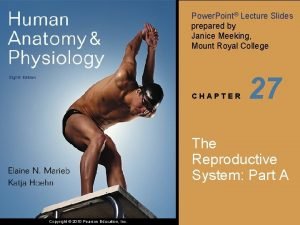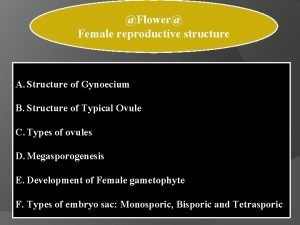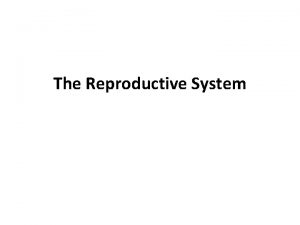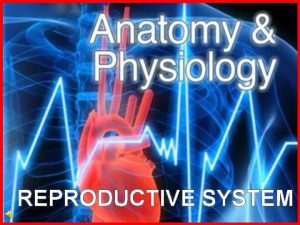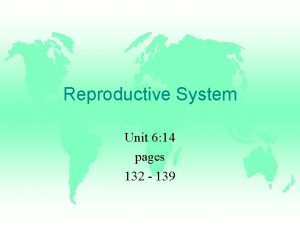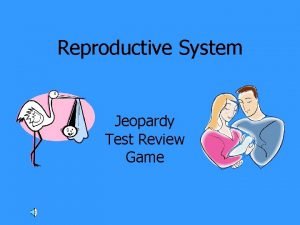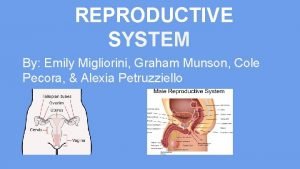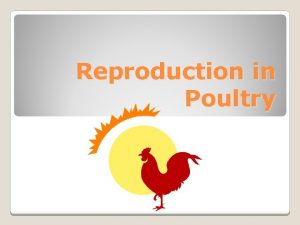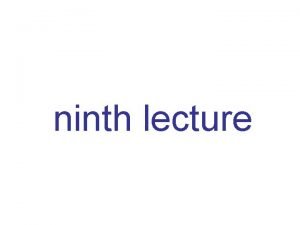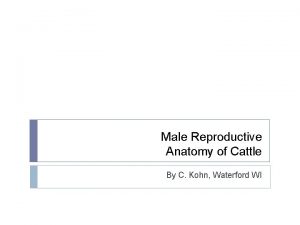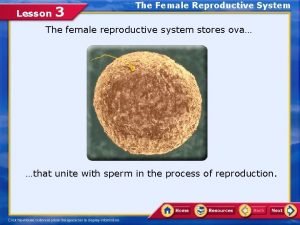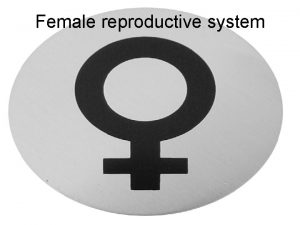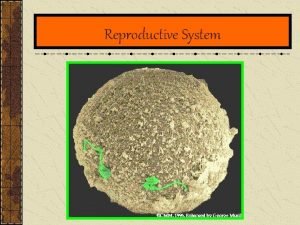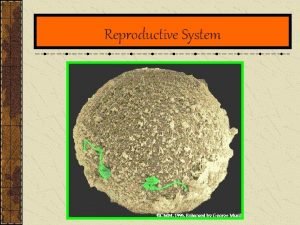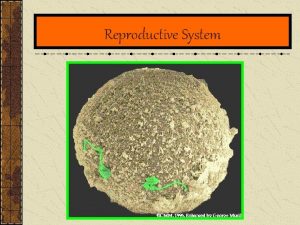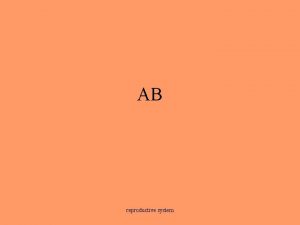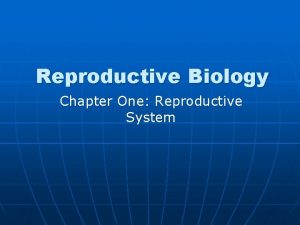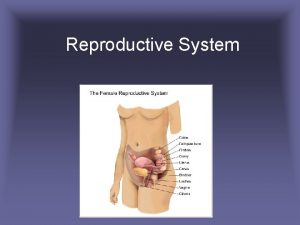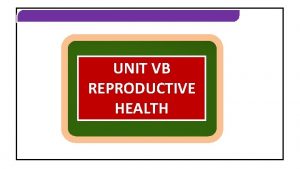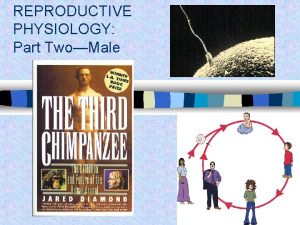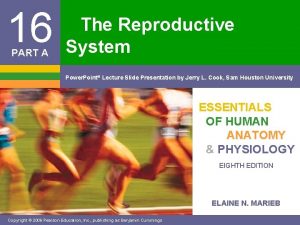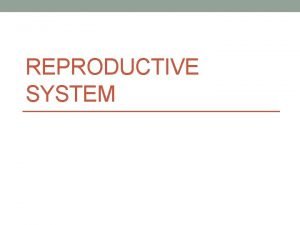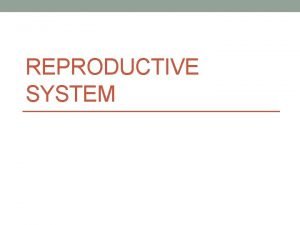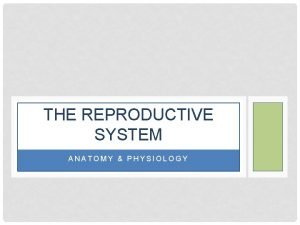16 PART C The Reproductive System Power Point



































- Slides: 35

16 PART C The Reproductive System Power. Point® Lecture Slide Presentation by Jerry L. Cook, Sam Houston University ESSENTIALS OF HUMAN ANATOMY & PHYSIOLOGY EIGHTH EDITION ELAINE N. MARIEB Copyright © 2006 Pearson Education, Inc. , publishing as Benjamin Cummings

Menstrual (Uterine) Cycle § Cyclic changes of the endometrium § Regulated by cyclic production of estrogens and progesterone § Stages of the menstrual cycle § Menses – functional layer of the endometrium is sloughed § Proliferative stage – regeneration of functional layer § Secretory stage – endometrium increases in size and readies for implantation Copyright © 2006 Pearson Education, Inc. , publishing as Benjamin Cummings

Hormonal Control of the Ovarian and Uterine Cycles Figure 16. 12 a, b Copyright © 2006 Pearson Education, Inc. , publishing as Benjamin Cummings

Hormonal Control of the Ovarian and Uterine Cycles Figure 16. 12 c, d Copyright © 2006 Pearson Education, Inc. , publishing as Benjamin Cummings

Hormone Production by the Ovaries § Estrogens § Produced by follicle cells § Cause secondary sex characteristics § Enlargement of accessory organs § Development of breasts § Appearance of pubic hair § Increase in fat beneath the skin § Widening and lightening of the pelvis § Onset of menses Copyright © 2006 Pearson Education, Inc. , publishing as Benjamin Cummings

Hormone Production by the Ovaries § Progesterone § Produced by the corpus luteum § Production continues until LH diminishes in the blood § Helps maintain pregnancy Copyright © 2006 Pearson Education, Inc. , publishing as Benjamin Cummings

Mammary Glands § Present in both sexes, but only function in females § Modified sweat glands § Function is to produce milk § Stimulated by sex hormones (mostly estrogens) to increase in size Copyright © 2006 Pearson Education, Inc. , publishing as Benjamin Cummings

Anatomy of Mammary Glands § Areola – central pigmented area § Nipple – protruding central area of areola § Lobes – internal structures that radiate around nipple § Alveolar glands – clusters of milk producing glands within lobules § Lactiferous ducts – connect alveolar glands to nipple Copyright © 2006 Pearson Education, Inc. , publishing as Benjamin Cummings

Stages of Pregnancy and Development § Fertilization § Embryonic development § Fetal development § Childbirth Copyright © 2006 Pearson Education, Inc. , publishing as Benjamin Cummings

Fertilization § The oocyte is viable for 12 to 24 hours after ovulation § Sperm are viable for 12 to 48 hours after ejaculation § Sperm cells must make their way to the uterine tube for fertilization to be possible Copyright © 2006 Pearson Education, Inc. , publishing as Benjamin Cummings

Mechanisms of Fertilization § Membrane receptors on an oocyte pulls in the head of the first sperm cell to make contact § The membrane of the oocyte does not permit a second sperm head to enter § The oocyte then undergoes its second meiotic division § Fertilization occurs when the genetic material of a sperm combines with that of an oocyte to form a zygote Copyright © 2006 Pearson Education, Inc. , publishing as Benjamin Cummings

The Zygote § First cell of a new individual § The result of the fusion of DNA from sperm and egg § The zygote begins rapid mitotic cell divisions § The zygote stage is in the uterine tube, moving toward the uterus Copyright © 2006 Pearson Education, Inc. , publishing as Benjamin Cummings

The Embryo § Developmental stage from the start of cleavage until the ninth week § The embryo first undergoes division without growth § The embryo enters the uterus at the 16 -cell state § The embryo floats free in the uterus temporarily § Uterine secretions are used for nourishment Copyright © 2006 Pearson Education, Inc. , publishing as Benjamin Cummings

The Blastocyst § Ball-like circle of cells § Begins at about the 100 cell stage § Secretes human chorionic gonadotropin (h. CG) to produce the corpus luteum to continue producing hormones § Functional areas of the blastocyst § Trophoblast – large fluid-filled sphere § Inner cell mass Copyright © 2006 Pearson Education, Inc. , publishing as Benjamin Cummings

The Blastocyst § Primary germ layers are eventually formed § Ectoderm – outside layer § Mesoderm – middle layer § Endoderm – inside layer § The late blastocyst implants in the wall of the uterus (by day 14) Copyright © 2006 Pearson Education, Inc. , publishing as Benjamin Cummings

Derivatives of Germ Layers § Ectoderm § Nervous system § Epidermis of the skin § Endoderm § Mucosae § Glands § Mesoderm § Everything else Copyright © 2006 Pearson Education, Inc. , publishing as Benjamin Cummings

Development from Ovulation to Implantation Figure 16. 15 Copyright © 2006 Pearson Education, Inc. , publishing as Benjamin Cummings

Development After Implantation § Chorionic villi (projections of the blastocyst) develop § Cooperate with cells of the uterus to form the placenta § The embryo is surrounded by the amnion (a fluid filled sac) § An umbilical cord forms to attach the embryo to the placenta Copyright © 2006 Pearson Education, Inc. , publishing as Benjamin Cummings

Development After Implantation Figure 16. 16 Copyright © 2006 Pearson Education, Inc. , publishing as Benjamin Cummings

Functions of the Placenta § Forms a barrier between mother and embryo (blood is not exchanged) § Delivers nutrients and oxygen § Removes waste from embryonic blood § Becomes an endocrine organ (produces hormones) and takes over for the corpus luteum § Estrogen § Progesterone § Other hormones that maintain pregnancy Copyright © 2006 Pearson Education, Inc. , publishing as Benjamin Cummings

The Fetus (Beginning of the Ninth Week) § All organ systems are formed by the end of the eighth week § Activities of the fetus are growth and organ specialization § A stage of tremendous growth and change in appearance Copyright © 2006 Pearson Education, Inc. , publishing as Benjamin Cummings

The Effects of Pregnancy on the Mother § Pregnancy – period from conception until birth § Anatomical changes § Enlargements of the uterus § Accentuated lumbar curvature § Relaxation of the pelvic ligaments and pubic symphysis due to production of relaxin Copyright © 2006 Pearson Education, Inc. , publishing as Benjamin Cummings

Effects of Pregnancy on the Mother § Physiological changes § Gastrointestinal system § Morning sickness is common due to elevated progesterone § Heartburn is common because of organ crowding by the fetus § Constipation is caused by declining motility of the digestive tract Copyright © 2006 Pearson Education, Inc. , publishing as Benjamin Cummings

Effects of Pregnancy on the Mother § Physiological changes § Urinary System § Kidneys have additional burden and produce more urine § The uterus compresses the bladder Copyright © 2006 Pearson Education, Inc. , publishing as Benjamin Cummings

Effects of Pregnancy on the Mother § Physiological changes § Respiratory System § Nasal mucosa becomes congested and swollen § Vital capacity and respiratory rate increase Copyright © 2006 Pearson Education, Inc. , publishing as Benjamin Cummings

Effects of Pregnancy on the Mother § Physiological changes § Cardiovascular system § Body water rises § Blood volume increases by 25 to 40 percent § Blood pressure and pulse increase § Varicose veins are common Copyright © 2006 Pearson Education, Inc. , publishing as Benjamin Cummings

Childbirth (Partition) § Labor – the series of events that expel the infant from the uterus § Initiation of labor § Estrogen levels rise § Uterine contractions begin § The placenta releases prostaglandins § Oxytocin is released by the pituitary § Combination of these hormones produces contractions Copyright © 2006 Pearson Education, Inc. , publishing as Benjamin Cummings

Initiation of Labor Figure 16. 18 Copyright © 2006 Pearson Education, Inc. , publishing as Benjamin Cummings

Stages of Labor § Dilation § Cervix becomes dilated § Uterine contractions begin and increase § The amnion ruptures Copyright © 2006 Pearson Education, Inc. , publishing as Benjamin Cummings

Stages of Labor § Expulsion § Infant passes through the cervix and vagina § Normal delivery is head first § Placental stage § Delivery of the placenta Copyright © 2006 Pearson Education, Inc. , publishing as Benjamin Cummings

Stages of Labor Figure 16. 19 Copyright © 2006 Pearson Education, Inc. , publishing as Benjamin Cummings

Developmental Aspects of the Reproductive System § Gender is determined at fertilization § Males have XY sex chromosomes § Females have XX sex chromosomes § Gonads do not begin to form until the eighth week Copyright © 2006 Pearson Education, Inc. , publishing as Benjamin Cummings

Developmental Aspects of the Reproductive System § Testes form in the abdominal cavity and descend to the scrotum one month before birth § The determining factor for gonad differentiation is testosterone Copyright © 2006 Pearson Education, Inc. , publishing as Benjamin Cummings

Developmental Aspects of the Reproductive System § Reproductive system organs do not function until puberty § Puberty usually begins between ages 10 and 15 § The first menses usually occurs about two years after the start of puberty § Most women reach peak reproductive ability in their late 20 s Copyright © 2006 Pearson Education, Inc. , publishing as Benjamin Cummings

Developmental Aspects of the Reproductive System § Menopause occurs when ovulation and menses cease entirely § Ovaries stop functioning as endocrine organs § There is a no equivalent of menopause in males, but there is a steady decline in testosterone Copyright © 2006 Pearson Education, Inc. , publishing as Benjamin Cummings
 Art-labeling activity: the male reproductive system, part 1
Art-labeling activity: the male reproductive system, part 1 Vesicular (graafian) follicle
Vesicular (graafian) follicle Endocrine system and reproductive system
Endocrine system and reproductive system Real power and reactive power
Real power and reactive power Power bi power point
Power bi power point Point point power
Point point power Gynoecium female reproductive part
Gynoecium female reproductive part Power angle curve in power system stability
Power angle curve in power system stability Male reproductive system from front
Male reproductive system from front Male genital hygiene
Male genital hygiene Development of female reproductive system
Development of female reproductive system Female reproductive system with baby
Female reproductive system with baby The reproductive system chapter 16
The reproductive system chapter 16 Exercise 42 review male reproductive system
Exercise 42 review male reproductive system Ovarian structures
Ovarian structures Uterus layers histology
Uterus layers histology Female reproductive system pregnancy
Female reproductive system pregnancy Epidiymitis
Epidiymitis Figure 28-1 the male reproductive system
Figure 28-1 the male reproductive system Reproductive system jeopardy
Reproductive system jeopardy What is reproductive system
What is reproductive system Chapter 16 reproductive system
Chapter 16 reproductive system Reproductive system definition
Reproductive system definition Luteinizing hormone in male reproductive system
Luteinizing hormone in male reproductive system Poultry reproductive system
Poultry reproductive system Male reproductive system in plants
Male reproductive system in plants Objectives of poultry production
Objectives of poultry production Male reproductive system information
Male reproductive system information Where is sperm located
Where is sperm located Male reproductive system
Male reproductive system Male genital anatomy front view
Male genital anatomy front view Unit 5 lesson 3 the female reproductive system
Unit 5 lesson 3 the female reproductive system Examples of asexual reproduction
Examples of asexual reproduction Function of male reproductive system
Function of male reproductive system Bony vs cartilaginous fish
Bony vs cartilaginous fish Ovary diagram
Ovary diagram
